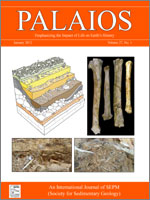Herein we provide the first report of the diversity of fungi and fungus-like organisms within a Mesozoic hot spring ecosystem. The Jurassic San Agustín hot spring deposit (Patagonia, Argentina), represents only the second known Phanerozoic hot spring ecosystem with an associated microflora and contains diverse, exceptionally preserved microorganisms. Preserved propagules include flask-shaped pycnidia produced by extant coelomycetes, shield-like and nearly round thyriothecia of extant Microthyriales in the ascomycetes, variously shaped spore-like bodies representing chytrid and chytrid-like zoosporangia and other life cycle forms, and additional fungal and fungus-like remains (spores, hyphal fragments, reproductive structures) of uncertain affinity. Many of these microorganisms are associated with variously decayed organic remains, most commonly of horsetails. This expands the fungal fossil record and provides a unique opportunity to learn about the biology of Mesozoic microorganisms.
BioOne.org will be down briefly for maintenance on 17 December 2024 between 18:00-22:00 Pacific Time US. We apologize for any inconvenience.
How to translate text using browser tools
1 January 2012
FIRST REPORT OF FUNGI AND FUNGUS-LIKE ORGANISMS FROM MESOZOIC HOT SPRINGS
JUAN GARCÍA MASSINI,
ALAN CHANNING,
DIEGO M GUIDO,
ALBA B ZAMUNER
ACCESS THE FULL ARTICLE
It is not available for individual sale.
This article is only available to subscribers.
It is not available for individual sale.
It is not available for individual sale.
<
Previous Article
|

PALAIOS
Vol. 27 • No. 1
January 2012
Vol. 27 • No. 1
January 2012




